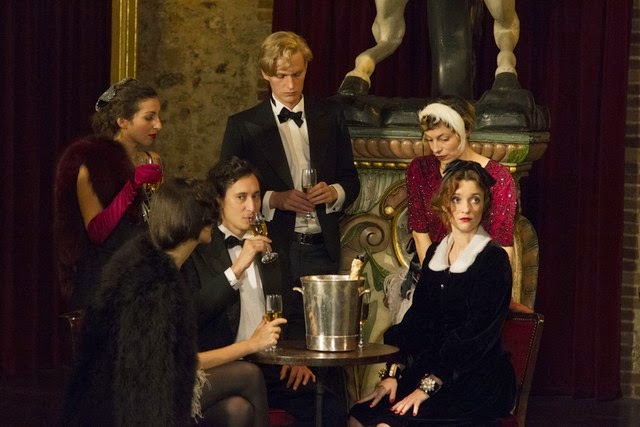Cannes Report 3 - 66th Festival de Cannes
By Moira Sullivan
 |
| Opium directed by Arielle Dombasle |
For
the 50th anniversary of the death of Jean Cocteau, who was twice the
president of the festival, a newly restored digitalization of Cocteau's beloved La
Belle et Le Bête was screened as part of the Cannes Classics sidebar of the
festival, followed by a dramatization of a party of his life. It is difficult
to make a biopic about a legend such as Jean Cocteau who spent time in Côte
d’Azur and painted frescos in a museum in nearby Villefranche sur Mer. To their
credit, the ensemble cast tried to breathe life into a short history of the
film poet in a creative assemblage of Cocteau’s life and words when he was an
opium addict. The title of the film is therefore to the point: Opium. The film
is directed by Arielle Dombasle with an excellent Grégoire Colin as Cocteau.
“Opium”
focuses on Cocteau’s short relationship with the French author Raymond Radiguet
(Sam Mercer), a young bon vivant with Arthur Rimbaud like behavior: wild,
playful and promiscuous. The film suggests that Cocteau became an opium addict
after Radiguet’s tragic death at age 20 from eating shellfish, but according to
Radiguet’s biographer, he died of typhoid fever.
The
beautiful actress Marisa Berensen as “La Marquise Casati” (from Cabaret 1972)
is part of the elite crowd who surrounds Cocteau. One of Cocteau’s patrons,
Marie-Laure de Noailles is played by Hèléne Filliéres, and Arielle Dombasle
plays “Mnémosyne”. Other characters brought to life include Nijinski, Man Ray,
Coco Chanel, Tristan Tzara, André Breton and Serge Diaghilev. At this event I met the remarkable journalist,
Nicole Gabriel for Jeune Cinema, a journal that began in 1964 to accompany the
Jean Vigo Cinema Society for youth– The form is unique today –a large format in
black and white, with no ads, which is rare in film criticism.
Another
formidable side event at the festival is Cinéma de la Plage: Cinema on the
Beach
 |
| Tippi Hedren in "The Birds" |
A series of classic films are shown in open air on the Croisette
and on closing night it was Hitchcock’s “The Birds”. This event must be
attended on time, since once it starts no one is allowed to enter once the film
starts but patrons huddle in the sand on the adjoining beachfronts and above on
the sidewalk.
The immense size of the screen and the amplification of
sound makes it an event that attracted regular patrons and pedestrians. The
girders that support the screen are partly submerged in water close to the
shore so it is an amazing screening.
It was comforting to hear the lines of Melanie Tippi Hedren informing
Annie (Susanne Pleshette) that she just drove up from San Francisco and to see
the beautiful nature of Bodega Bay, unencumbered at the time in 1960s by land
development- This is an area that Hitchcock loved and his reverence shows. From
the beach one could hear party music from the palatial beach tents on the
Croisette and nearby docked yachts, all to disperse the morning after.
Cannes is a chaotic blend of stardom and opulence, commercial
cinema and arthouse with moguls and cineastes and devoted to both. For myself, It is truly a festival where it
is possible to see great film and meet colleagues from around the world who
join to celebrate cinema – what the Italian film theoretician Ricciotta
Canudo called the seventh art in a
manifesto from 1911- an amalgamation of spatial arts architecture sculpture
and painting with temporal arts dance music
poetry. It is clear to me that all this can be
experienced in Cannes.
For Movie Magazine this is Moira Sullivan, Cannes
© 2013 - Movie Magazine International - Air Date:06/05/13
Movie Magazine International
Movie Magazine International
Comments
Post a Comment